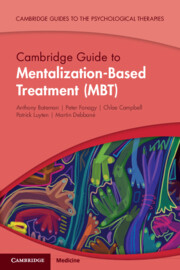Book contents
- Cambridge Guide to Mentalization-Based Treatment (MBT)
- Cambridge Guides to the Psychological Therapies
- Reviews
- Cambridge Guide to Mentalization-Based Treatment (MBT)
- Copyright page
- Contents
- Preface
- A Note from the Series Editor
- Acknowledgments
- Part I Overview of the Model
- Part II The Mentalization-Based Treatment Model in Practice
- Part III Application and Adaptations for Mental Health Presentations
- Chapter 6 Narcissistic Personality Disorder
- Chapter 7 Antisocial Personality Disorder
- Chapter 8 Avoidant Personality Disorder
- Chapter 9 Depression
- Chapter 10 Psychosis
- Chapter 11 Trauma
- Chapter 12 Eating Disorders
- Part IV Application of Mentalization-Based Treatment in Different Populations and in Different Settings
- Index
- References
Chapter 10 - Psychosis
from Part III - Application and Adaptations for Mental Health Presentations
Published online by Cambridge University Press: 18 May 2023
- Cambridge Guide to Mentalization-Based Treatment (MBT)
- Cambridge Guides to the Psychological Therapies
- Reviews
- Cambridge Guide to Mentalization-Based Treatment (MBT)
- Copyright page
- Contents
- Preface
- A Note from the Series Editor
- Acknowledgments
- Part I Overview of the Model
- Part II The Mentalization-Based Treatment Model in Practice
- Part III Application and Adaptations for Mental Health Presentations
- Chapter 6 Narcissistic Personality Disorder
- Chapter 7 Antisocial Personality Disorder
- Chapter 8 Avoidant Personality Disorder
- Chapter 9 Depression
- Chapter 10 Psychosis
- Chapter 11 Trauma
- Chapter 12 Eating Disorders
- Part IV Application of Mentalization-Based Treatment in Different Populations and in Different Settings
- Index
- References
Summary
Mentalization-based treatment (MBT) for psychosis focuses on the decoupling of bodily and mental experience as well as the stresses of mentalizing during social interaction. In a framework of mentalizing, psychotic phenomena can be represented as severe disturbances to the experience of oneself as a coherent unit. Clinical treatment that aims to increase integration and stability of self-experience is illustrated in this chapter using clinical examples. The first task is to identify treatment objectives and define any obstacles to treatment, working with co-constructed representations of the clinical problem. The second task is to integrate the viewpoints of the patient, the clinical team, and the social care network, and to agree an overall working formulation. This is followed by therapeutic intervention to stabilize self-mentalizing using interventions from the core MBT model.
- Type
- Chapter
- Information
- Cambridge Guide to Mentalization-Based Treatment (MBT) , pp. 253 - 276Publisher: Cambridge University PressPrint publication year: 2023
References
- 1
- Cited by

